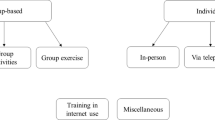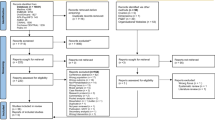Abstract
Purpose
To determine the feasibility (recruitment, retention, and adherence rates) of implementing a multi-dimensional knowledge translation (KT) intervention designed for women with breast cancer, and to explore preliminary estimates of effects of the implementation strategy on exercise level, exercise knowledge and behavior, health-related quality of life, and overall health status among breast cancer survivors.
Methods
Design: Implementation Trial. Participants: Community-dwelling women, over 18 years of age, currently undergoing chemotherapy for stage 1–3 BRCA. Randomization and Blinding: A blinded researcher randomized participants on a record-by-record basis to the intervention or control group. A researcher blinded to the group allocation of the participants conducted the statistical analysis. Intervention Group: Eight sessions of moderate intensity aerobic exercise along with eight self-management modules were delivered during chemotherapy within the cancer institution. Control Group: Usual care. Primary Outcome: Feasibility of implementation strategy measured through recruitment, retention, and adherence rates.
Results
Twenty-nine women were screened for this study. Twenty-seven met inclusion criteria and twenty-six participants were enrolled in the study. The implementation strategy was determined to be feasible and had a recruitment rate of 96%, retention rate of 100%, and adherence rate of 89%. The intervention group had significantly higher exercise levels (mean difference = 25.38, 95%CI = (9.35, 41.42)) post-intervention compared with the control group. No adverse events were reported.
Conclusions
The implementation of this KT intervention is feasible and demonstrates preliminary effects for secondary outcomes for women with breast cancer during chemotherapy. Findings support the implementation of this intervention in a multi-center trial.
Trial registration
NCT03087461

Similar content being viewed by others
References
Canadian Cancer Society’s Advisory Committee on Cancer Statistics (2017) Canadian Cancer Statistics 2017. http://www.cancer.ca/~/media/cancer.ca/CW/cancer%20information/cancer%20101/Canadian%20cancer%20statistics/Canadian-Cancer-Statistics-2017-EN.pdf?la=en. Accessed 21 Feb 2018
Cella D, Fallowfield LJ (2011) Recognition and management of treatment-related side effects for breast cancer patients receiving adjuvant endocrine therapy. Breast Cancer Res Treat 107(2):167–180
Ewertz M, Jensen AB (2011) Late effects of breast cancer treatment and potentials for rehabilitation. Acta Oncol 50(2):187–193
Dennett AM, Peiris CL, Shields N, Prendergast LA, Taylor NF (2016) Moderate-intensity exercise reduces fatigue and improves mobility in cancer survivors: a systematic review and meta-regression. J Physiother 62(2):68–82
Schmitz KH, Courneya KS, Matthews C, Demark-Wahnefried W, Galvão DA, Pinto BM, Irwin ML, Wolin KY, Segal RJ, Lucia A, Schneider CM, von Gruenigen V, Schwartz AL, American College of Sports Medicine (2010) American College of Sports Medicine roundtable on exercise guidelines for cancer survivors. Med Sci Sports Exerc 42(7):1409–1426
van Vulpen JK, Peeters PHM, Velthuis MJ, van der Wall E, May AM (2016) Effects of physical exercise during adjuvant breast cancer treatment on physical and psychosocial dimensions of cancer-related fatigue: a meta-analysis. Maturitas 85:104–111
Travier N, Velthuis MJ, Steins Bisschop CN et al (2015) Effects of an 18-week exercise programme started early during breast cancer treatment: a randomised controlled trial. BMC Med 8(13):121
Juvet LK, Thune I, Elvsaas IKO, Fors EA, Lundgren S, Bertheussen G, Leivseth G, Oldervoll LM (2017) The effect of exercise on fatigue and physical functioning in breast cancer patients during and after treatment and at 6 months follow-up: a meta-analysis. Breast 33:166–177
Schmitz KH, Ahmed RL, Troxel AB, Cheville A, Lewis-Grant L, Smith R, Bryan CJ, Williams-Smith CT, Chittams J (2010) Weight lifting for women at risk for breast cancer-related lymphedema a randomized trial. JAMA 304(24):2699–2705
McNeely ML, Campbell K, Ospina M et al (2010) Exercise interventions for upper-limb dysfunction due to breast cancer treatment. Cochrane Database Syst Rev 6:CD005211
Pedrinolla A, Ardigò LP, Salvagno GL et al (2016) Inflammatory response to exercise in a pancreatic-cancer patient: a case report. Pancreat Disord Ther 6:176. https://doi.org/10.4172/2165-7092.1000176
Brown JC, Huedo-Medina TB, Pescatello LS et al (2012) The efficacy of exercise in reducing depressive symptoms among cancer survivors: a Meta-analysis. PLoS One 7(1):e30955
Lahart IM, Metsios GS, Nevill AM, Carmichael AR (2015) Physical activity, risk of death and recurrence in breast cancer survivors: a systematic review and meta- analysis of epidemiological studies. Acta Oncol 54(5):635–654
Cormie P, Zopf EM, Zhang X, Schmitz KH (2017) The impact of exercise on cancer mortality, recurrence, and treatment-related adverse effects. Epidemiol Rev 39(1):71–92
Fernandez S, Franklin J, Amlani N et al (2015) Physical activity and cancer: a cross-sectional study on the barriers and facilitators to exercise during cancer treatment. Can Oncol Nurs J 42(1):37–72
Courneya KS, Katzmarzyk PT, Bacon E (2008) Physical activity and obesity in Canadian cancer survivors. Cancer 112(11):2475–2482
Smith-Turchyn J, Richardson J, McNeely M et al (2016) Physical activity and breast cancer: a study on the barriers and facilitators to exercise promotion from the perspective of health care professionals. Physiother Can 68(4):383–390
Canadian Institute of Health Research (2019) Knowledge translation – definition. http://www.cihr-irsc.gc.ca/e/29418.html#2. Accessed 21 Feb 2018
Smith-Turchyn J, Richardson J, Tozer R et al (2018) Physical activity and breast cancer: results of a focus group to devise novel exercise interventions for women with breast cancer. Clin Nurs Stud 6(2):39–46
Canadian Cancer Society’s Advisory Committee on Cancer Statistics (2015) Canadeian Cancer Statistics 2015. Canadian Cancer Society. http://www.cancer.ca/~/media/cancer.ca/CW/cancer%20information/cancer%20101/Canadian%20cancer%20statistics/Canadian-Cancer-Statistics- 2015-EN.pdf?la=en. Accessed 4 April 2018
Franek J (2013) Self-management support interventions for persons with chronic disease: an evidence-based analysis. Ont Health Technol Assess Ser 13(9):1–60
Foster G, Taylor SJ, Eldridge SE et al (2007) Self-management education programmes by lay leaders for people with chronic conditions. Cochrane Database Syst Rev 4:CD005108
Grady PA, Gough LL (2014) Self-management: a comprehensive approach to management of chronic conditions. Am J Public Health 104(8):e25–e31
Van Dijck S, Neilssen P, Verbelen H et al (2016) The effects of physical self- management on quality of life in breast cancer patients: a systematic review. Breast 28:20–28
Boogaard L, Gater L, Mori M, Trincao A, Smith-Turchyn J (2016) Efficacy of self-management programs in managing side effects of breast cancer: a systematic review and meta-analysis of randomized control trials. Rehabil Oncol 34(1):14–26
Everitt B (2006) Medical statistics from A to Z: a guide for clinicians and medical students. Cambridge University Press, Cambridge
Thabane L, Ma J, Chu R, Cheng J, Ismaila A, Rios LP, Robson R, Thabane M, Giangregorio L, Goldsmith CH (2010) A tutorial on pilot studies: the what, why and how. BMC Med Res Methodol 10(1)
Smith-Turchyn J, Richardson J, Tozer R et al (2017) Bridging the gap: incorporating exercise evidence into clinical practice in breast cancer care in Ontario-a Pilot Randomized Control Trial Protocol. Cancer Stud Ther J 2(2):1–5
Canadian Society of Exercise Physiologists (2018) Canadian physical activity guidelines. http://csep.ca/CMFiles/Guidelines/CSEP_PAGuidelines_0-65plus_en.pdf. Accessed 03 July 2018
Godin G, Shephard R (1985) A simple method to assess exercise behavior in the community. Can J Appl Sport Sci 10(3):141–146
Amireault S, Godin G, The Godin-Shephard Leisure-Time Physical Activity Questionnaire (2015) Validity evidence supporting its use for classifying healthy adults into active and insufficiently active categories. Percept Mot Skills 120(2):604–622
Amireault S, Godin G, Lacombe J, Sabiston CM (2015) Validation of the Godin-Shephard Leisure-Time Physical Activity Questionnaire classification coding system using accelerometer assessment among breast cancer survivors. J Cancer Surviv 9(3):532–540
Amireault S, Godin G, Lacombe J, Sabiston CM (2015) The use of the Godin-Shephard Leisure-Time Physical Activity Questionnaire in oncology research: a systematic review. BMC Med Res Methodol 15:60
McEachan RR, Conner M, Taylor NT et al (2011) Prospective prediction of health- related behaviours with the Theory of Planned Behaviour: a meta- analysis. Health Psychol Rev 5(2):97–144
Courneya KS, Friedenreich CM (1999) Utility of the Theory of Planned Behavior for understanding exercise during breast cancer treatment. Psycho-oncol 8(2):112–122
Ajzen I Constructing a Theory of Planned Behaviour Questionnaire. https://people.umass.edu/aizen/pdf/tpb.measurement.pdf. Accessed 3 July 2018
Brady MJ, Cella DF, Mo F, Bonomi AE, Tulsky DS, Lloyd SR, Deasy S, Cobleigh M, Shiomoto G (1997) Reliability and validity of the functional assessment of cancer therapy-breast quality of life instrument. J Clin Oncol 15(3):974–986
EuroQOL Group (2015) EQ-5D-3L user guide: basic information on how to use the EQ-5D-3L instrument. Version 5.1. https://euroqol.org/wp-content/uploads/2016/09/EQ-5D-3L_UserGuide_2015.pdf. Accessed 4 April 2018
Simon Pickard A, Wilke C, Lin H et al (2007) Health utilities using the EQ-5D in studies of cancer. Pharmacoeconomics 25(5):365–384
Hertzog MA (2008) Considerations in determining sample size for pilot studies. Res Nurs Health 31:180–191
Cocks K, Torgerson D (2013) Sample size calculations for pilot randomized trials: a confidence interval approach. J Clin Epidemiol 66:197–201
Linke SR, Gallo LC, Norman GJ (2011) Attrition and adherence rates of sustained versus intermittent exercise interventions. Ann Behav Med 42(2):197–209
Courneya KS, Segal RJ, Mackey JR, Gelmon K, Reid RD, Friedenreich CM, Ladha AB, Proulx C, Vallance JKH, Lane K, Yasui Y, McKenzie DC (2007) Effects of aerobic and resistance exercise in breast cancer patients receiving adjuvant chemotherapy: a multicenter randomized controlled trial. J Clin Oncol 25(28):4396–4340
Adamsen L, Quist M, Andersen C et al (2009) Effect of a multimodal high intensity exercise intervention in cancer patients undergoing chemotherapy: randomised controlled trial. BMJ 339:b3210
Courneya KS, McKenzie DC, Mackey JR et al (2014) Subgroup effects in a randomized trial of different types and doses of exercise during breast cancer chemotherapy. Br J Cancer 111:1718–1725
Abshire M, Dinglas VD, Cajita MI et al (2017) Participant retention practices in longitudinal clinical research studies with high retention rates. BMC Med Res Methodol 17(1):30
Courneya KS, Segal RJ, Gelmon K, Mackey JR, Friedenreich CM, Yasui Y, Reid RD, Proulx C, Trinh L, Dolan LB, Wooding E, Vallerand JR, McKenzie DC (2014) Predictors of adherence to different types and doses of supervised exercise during breast cancer chemotherapy. Int J Behav Nutr Phys 11:85
Leach HJ, Danyluk JM, Nishimura KC, Culos-Reed SN (2015) Evaluation of a community based program for breast cancer patients undergoing treatment. Cancer Nurs 38(6):417–423
Jones L, Courneya KS, Fairey AS et al (2004) Effects of an oncologist’s recommendation to exercise on self-reported exercise behavior in newly diagnosed breast cancer survivors: a single-blind, randomized controlled trial. Ann Behav Med 28(2):105–113
Blaney JM, Lowe-Strong A, Rankin-Watt J, Campbell A, Gracey JH (2013) Cancer survivors’ exercise barriers, facilitators and preferences in the context of fatigue, quality of life and physical activity participation: a questionnaire-survey. Psycho-Oncol 22:186–194
Andrykowski MA, Beachman AO, Jacobsen PB (2007) Prospective, longitudinal study of leisure-time exercise in women with early-stage breast cancer. Cancer Epidemiol Biomark Prev 16(3):430–438
Kwan ML, Sternfeld B, Ergas IJ, Timperi AW, Roh JM, Hong CC, Quesenberry CP, Kushi LH (2012) Change in physical activity during active treatment in a prospective study of breast cancer survivors. Breast Cancer Res Treat 131(2):679–690
Acknowledgments
We would like to thank Dr. L. Bordeleau, Dr. S. Mukherjee, Dr. O. Levine, and K. Ward for their help with recruitment for this study.
Funding
Jenna Smith-Turchyn was funded by the Vanier Canadian Graduate Scholarship for the duration of this project. The Hamilton Division of the Ontario Physiotherapy Association (OPA) provided funding for this study. The OPA had no role in the design of the study, collection, analysis, or interpretation of data.
Author information
Authors and Affiliations
Corresponding author
Ethics declarations
Informed consent was obtained from all individual participants included in the study.
Conflict of interest
The authors declare they have no conflict of interest.
Ethical approval
All procedures performed in studies involving human participants were in accordance with the ethical standards of the institutional and/or national research committee and with the 1964 Helsinki declaration and its later amendments or comparable ethical standards.
Additional information
Publisher’s note
Springer Nature remains neutral with regard to jurisdictional claims in published maps and institutional affiliations.
Rights and permissions
About this article
Cite this article
Smith-Turchyn, J., Richardson, J., Tozer, R. et al. Bridging the gap: incorporating exercise evidence into clinical practice in breast cancer care. Support Care Cancer 28, 897–905 (2020). https://doi.org/10.1007/s00520-019-04897-9
Received:
Accepted:
Published:
Issue Date:
DOI: https://doi.org/10.1007/s00520-019-04897-9




